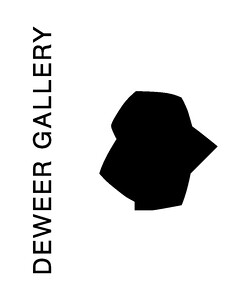September 12–October 7, 2018
Thomas Kratz - Jump To First
Los Angeles: carefree, relaxed and hedonistic? Or more like a major capital city polluted by car exhaust gases where people live in their own bubbles? The truth is somewhere in between. German artist Thomas Kratz immersed himself for three months. The creative explosion that that entailed is soon to be seen at Deweer Gallery, during his second solo exhibition in Otegem.
Los Angeles fueled Thomas Kratz’s desire to draw. On handmade, pastel-coloured Japanese paper or on local paper supports. And almost always on a small size. Striking is his childlike, naive signature. His style is semi-figurative, simple and light, and consists of cheerful colours, elegant curls and primary shapes. Sometimes innocent, like a little heart or a cloud, sometimes sexually tinted. But always playful, and with a nod to toilet graffiti. The drawings are like a slippery fish in an aquarium. They have no narrative, the real meaning always escapes us.
The sprawling metropolis also gave Thomas Kratz a fresh look and the right tone to finish his paintings in his studio in Berlin. It is noteworthy that the artist starts from coloured supports, as he also does for his drawings. And he experiments with oil paint for the first time—in addition to gouache, aluminum paint, ink and spray paint, which we have seen in his earlier work. The romantic touch of and the possibilities of texture created with oil paint attract him.
For Thomas Kratz, drawing and painting is like inhaling and exhaling. A necessity. An energy. A continuous search for an answer to his starting point, namely the material and the colour of the support. And that answer is vital, transparent and free.
Imi Knoebel
Imi Knoebel (b. 1940, Dessau), one of the most prominent, post-war German artists, exhibits for the third time at Deweer Gallery. His work has already been shown in Otegem in the nineties, during the group show To Return to Base (1991) and the solo exhibition Porträts (1992) featuring four legendary images of the idea ‘portrait’.
In his artistic practice Imi Knoebel resolutely opts for geometric abstraction and playful variants, which find expression through various media. From drawing, painting and sculpture to photography, projection and installation. As heir of Malevich, Mondriaan and the Bauhaus, he investigates the fundamentals of painting: form, color and material—and their relation to architecture. Noteworthy are his choice for minimal compositions, his deliberate—subtle or just very commanding—use of color and his exploration of basic materials such as aluminum. One of his most legendary works is Raum 19 (1968), a gigantic installation consisting of elementary basic forms in wood and fibreboard, which he designed as a student and pupil of Joseph Beuys. In addition, his stained-glass windows (realized in 2011 and 2015) for the Notre-Dame Cathedral in Reims, France, are world-famous.
*Imi Knoebel is born as Wolf Knoebel. His first name ‘Imi’ dates from the second half of the sixties. Together with his good friend Rainer Giese he formed the radical artist duo ‘Imi&Imi’. Imi is an abbreviation of ‘Ich mit Ihm’, an ironic reference to their admiration for avant-garde artist Malevich, with whom they identified. Imi was also the name of an East German washing detergent sold with the slogan ‘a guarantee for uncompromising purity’.
Belgium Calling - Part I
Deweer Gallery is presenting Belgium calling, an exhibition providing a stage for home grown artists. Although small in size, Belgium does offer a rich variety of artistic top talent. In Belgium we find many artists who enter into dialogue and confrontation with reality and the public, who profile themselves as thinkers against the grain or as a servants of beauty. Early talent scouting and supporting is one of the driving forces of Deweer Gallery. Representing the diverse nature of contemporary art, the used media range from painting, drawing and sculpture to photography, video and installation. Some artists are only in the spring of their lives, such as Stevie Dix (b.1990) whose starting oeuvre bears witness to a raw, determined painting quality. In addition to names featured on the mainstream art scene, such as Panamarenko, Jan Fabre and Koen Vanmechelen, this exhibition is also an excellent opportunity to (re)discover—unjustly overlooked—pearls. Just think of the autonomous, photographic portraits of children made by Marie-Jo Lafontaine. They seem to remind us of the—since the original sin?—lost innocence. Or the clever installations of Stefaan Dheedene in which he appears and disappears at the same time.
Participating artists: Michael Aerts, Jan De Cock, Franky Deconinck, Stephan Dheedene, Stevie Dix, Jan Fabre, Marie-Jo Lafontaine, Panamarenko, Johan Tahon, Hans Vandekerckhove, Koen Vanmechelen, Andy Wauman, …


